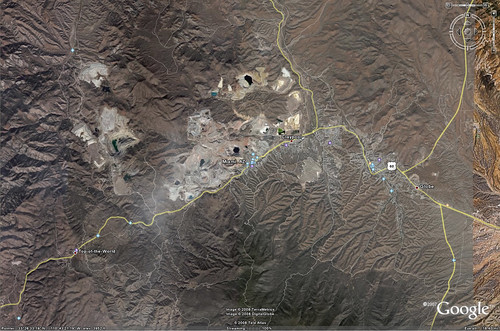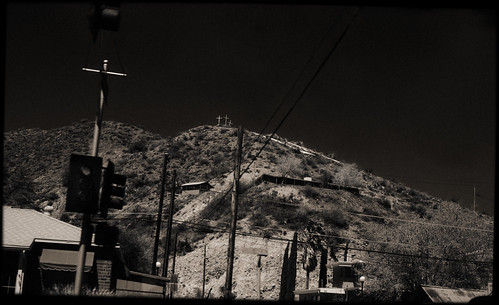The last leg of the trip is the return.
East of Phoenix, we passed through mountains filled with monolithic Easter Island rocks into mining territory landscapes of pityless or pitiful Golgothas, I don’t know which, and the surrounding communities look none the richer for it.

Open Pit Mine, Miami, Arizona, 2008

Google Earth view of Open Pit Mining, Miami, Arizona and Vicinity
In Google Maps, compare the size of the town to the open pit mining area.
What you are looking at was once a holding of the Phelps Dodge Corporation, founded in 1834, but acquired in 2007 by Freeport-McMoRan.
Phelps Dodge has been named as a “potentially responsible party in at least 13 Superfund toxic waste sites” and the 23rd largest corporate producer of air pollution in the United States.
According to Wikipedia, the Phelps Dodge Corporation, its initial business being the shipping of antebellum cotton to England in exchange for metals, eventually began its own mining operations in the west. That company, which had its beginning in slavery-produced cotton (in a truly bizarre twist, William Earle Dodge, one of the founders of Phelps Dodge, is given as having become a “noted abolitionist” as well as an activist for American Indian rights) Wikipedia notes as becoming “notorious for its anti-union views, primarily for its kidnapping of nearly 1,300 striking miners and the seizure of the telegraph and telephone lines in the town of Bisbee, Arizona, during the Bisbee Deportation in 1917…The Phelps Dodge copper mine at Morenci, Arizona was the site of a violent strike from 1983 to 1986, culminating in one of the largest union decertifications in American labor history.”
In 1917, 2000 vigilantes of Phelps Dodge kidnapped 1300 striking mine workers, supporters and citizen bystanders. A machine gun trained on them by the sheriff, they were marched two miles from the post office to a baseball park, then were transported 200 miles, by cattle cars, 16 hours through the desert without food or water, to Hermanas, New Mexico, where they were deposited without money and told not to show their faces again in Bisbee.
This was in July.
200 miles, by cattle cars, in July, from Arizona to New Mexico.
Among the demands of the peaceful strikers had been wanting an end to blasting while men were in the mine.
If you’d like, you can view the mines at Bisbee here in Google Maps.
You may remember that on our trip, several days earlier, we had visited the old copper town of Jerome and the Douglas Mansion there. Phelps Dodge did a test run of the Bisbee deportation with a similar one in Jerome, kidnapping 100 suspected IWW members, with the cooperation of the Yavapai County sheriff, holding them in the county jail then deporting 67 of them to Needles, California.
The Douglas Mansion at Jerome was built by Jimmy Douglas. His brother was Walter P. Douglas, who was General Manager of the Copper Queen Mine at Bisbee, property. Those 23 cattle cars that carried away the workers belonged to a railway owned by Douglas.
During the Bisbee Deportation, Phelps Dodge executives seized telegraph and telephone to prevent news of the deportation from being released, prevented Western Union from sending out wires, and gagged the press.
On May 15, 1918, the U.S. Department of Justice ordered the arrest of 21 Phelps Dodge executives, Calumet and Arizona Co. executives, and several Bisbee and Cochise County elected leaders and law enforcement officers. The arrestees included Walter Douglas, and would have included Sheriff Wheeler if he had not been serving in France with the American Expeditionary Force during World War I. A pre-trial motion by the defense led a federal district court to release the 21 men on the grounds that no federal laws had been violated. The Justice Department appealed. But in United States v. Wheeler, 254 U.S. 281 (1920), Chief Justice Edward Douglass White ruled for an 8-to-1 majority that no federal law protected the freedom of movement. Protecting citizens’ right to movement was a state function, White argued, and had to be enforced solely in state court.
But no state criminal charges were ever brought. Some workers filed civil suits, but the first civil jury found that the deportations had been good public policy and refused to grant relief. Most of the other suits were quietly dropped, although a few workers received payments in the $500 to $1,250 range.
The Bisbee Deportation proved to be a watershed for deportations in the United States. The public popularity of the Bisbee and Jerome deportations led many politicians to see deportation as an acceptable public policy. For several decades thereafter, deportation became American public policy. For example, on October 6, 1918, the Congress passed the Alien Act, which authorized the federal government to deport any alien who at any time (prior to or after his or her entry into the United States) supported or was a member of an anarchist organization. In December 1919, following the early Lusk Committee and Palmer Raids, the Alien Act of 1918 was used to deport nearly 250 labor union organizers and other suspected radicals without trial to Russia, aboard The Buford. In the 1930s, mass deportations led to the removal of up to 2 million Mexicans and Mexican Americans from the United States. In 1942, the federal government forcibly deported 120,000 Japanese Americans to the interior of the country in response to anti-Japanese hysteria following the attack on Pearl Harbor. In 1954, the federal government implemented Operation Wetback, a program created in response to public hysteria about illegal immigration. Operation Wetback led to the deportation of nearly 1.3 million Mexican workers. These and other examples of mass deportation drew their inspiration and acceptance from the Bisbee Deportation and the public support for that incident.
Source: Wikipedia
Some interesting history there.
The more things change, the more they stay the same.

Leave a Reply to nina Cancel reply